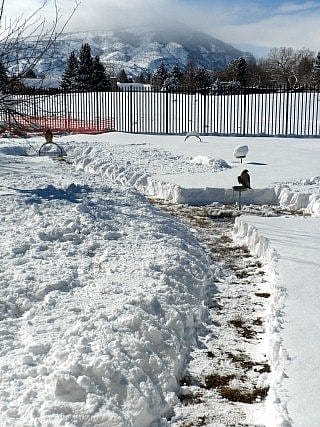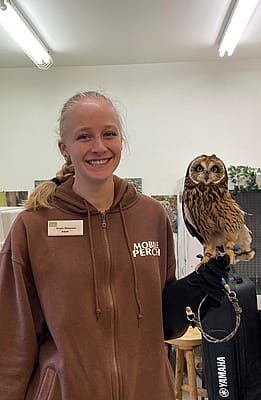
Weathering the Winter – Raptor Style!
This has been an incredible winter here in Cody, Wyoming! I’ve only lived here three years, but we’ve had more snow this winter than all my previous winters here combined! Don’t get me wrong, I’m not complaining. I LOVE winter and snow. I don’t even mind bitterly cold temps. The wind, however, I could do without. Anyway, with all the “winter” we’ve been having I’m frequently asked how the birds are doing and how we get through it. That’s easy . . . raptor style!!!
Many species of raptors thrive in cold and snowy environments: rough-legged hawks, bald eagles, snowy owls, etc. Of our six resident bird species, three (the great horned owl, golden eagle, and red-tailed hawk) have no trouble with the cold and snow at all. We have to do very little adjusting in our care of these birds to keep them happy and healthy. In fact Teasdale, like myself, prefers winter to summer. For these birds we simply make sure we replace their frozen water every few days (don’t worry, they get the majority of their water from their food, even in the wild), give them a bit more food on the cold nights, and make sure they don’t have to stand in snow which might cause problems with toes. Our birds never worry about this because around November we put plexiglass over their windows (which consist of pvc pipes to allow weather in but not let birds out) which keeps most snow and wind out.
Even a few American kestrels can be spotted in our area in the middle of winter – although most move a bit south. Peregrine falcons and turkey vultures, however, tend to head to warmer areas. So what do we do with ours? Suli (the turkey vulture) has a separate enclosure in our food prep area and it stays around 60 degrees or so for her. This winter we installed a personal wall heater in Hayabusa, the peregrine falcon’s, enclosure. It keeps her temp around 45 – 50 degrees which is just fine for her. Salem, our kestrel’s, entire enclosure is currently in our food prep area. Although he CAN handle some pretty cold temps, he never has to with us. Every chance we get, we bring the birds into sunny areas where they can absorb some much loved sun and vitamin D as well—you just have to shovel a path to the sunny places right now. 🙂
The biggest challenges come with performing our daily duties. Just getting from the main building out to the mews (about 50 yards) can be a challenge. First, the doors may be covered in frost and ice.
Next, you might not even be able to get your key in the lock without help.
Once you’re through the doors, it may take a while to get all the way out to the mews.
Even when the snow has started to melt you can have some big issues.
It can take some back-breaking labor for the birds to get a little sunlight in the weathering yard (where they go to enjoy the weather).
Although our birds are quite pampered, the temperatures can be a factor. We have had two pretty nasty cold snaps that took a toll on Teasdale’s food. He waits to eat until it’s dark and we’re gone which, when the temperature outside is –25 degrees at 3 p.m., means his food is frozen solid before he decides to eat. Luckily, the snaps were short and after missing one meal he figured out to start eating a bit sooner.
All in all, however, winter isn’t too bad for us here. The birds are spoiled, I have great volunteers to help me care for them, and I work with amazing staffers that do the really awful jobs (clearing the path) for us most days. So bring on the cold and snow! We can handle it. You can keep the wind, though, thanks.
Written By
Melissa Hill
While earning her Bachelor's Degree in Wildlife Management at the University of Wyoming, Melissa began volunteering at Laramie Raptor Refuge and was instantly hooked on birds of prey. Since those early days, she has worked with nearly 70 different raptors at four different raptor education groups in three states. She is a former member of the Education Committee for the International Association of Avian Trainers and Educators (IAATE) and a National Association for Interpretation's Certified Interpretive Guide. When she's not "playing with the birds" she enjoys spending time quilting, crocheting, and exploring the Greater Yellowstone Ecosystem with her non-bird family.



















